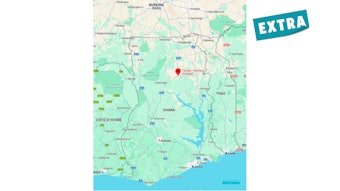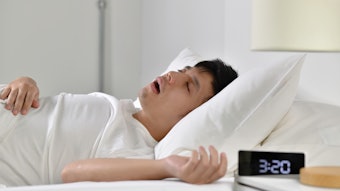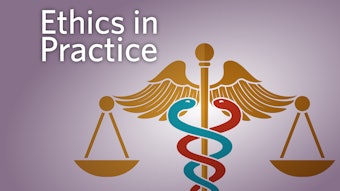Pearls from Your Peers: DISE and Obstructive Sleep Apnea
Elizabeth Willingham, MD, interviewed Jason Yu, MD, sleep specialist, on drug-induced sleep endoscopy (DISE) and the physiology of obstructive sleep apnea.

Jason L. Yu, MD, is a sleep surgeon and otolaryngologist at Emory University Hospital Midtown, Atlanta, in the Department of Otolaryngology–Head and Neck Surgery. Dr. Yu’s research centers on the use of drug-induced sleep endoscopy (DISE) to investigate the pathophysiology of obstructive sleep apnea (OSA), with an emphasis on how neuromuscular and ventilatory factors contribute to upper airway collapse during sleep. Elizabeth Willingham, MD, is a comprehensive otolaryngologist in the Department of Otolaryngology-Head and Neck Surgery at Emory. Dr. Willingham spoke with Dr. Yu on the clinical applications of DISE, how it has revolutionized surgical planning for sleep apnea patients, and the insights it provides into the complex physiology of upper airway collapse during sleep.
What Is DISE?
DISE stands for drug-induced sleep endoscopy. DISE is a dynamic upper airway evaluation performed under sedation to assess the pattern and degree of airway collapse in patients with OSA. Originally introduced by Croft and Pringle in 1991,1 DISE was developed to guide surgical planning by directly visualizing the airway during sedation that mimics a sleep-like state. Today, it has become a widely adopted tool for surgical planning in sleep apnea surgery.
The procedure is typically performed using propofol sedation, although other agents such as midazolam, fentanyl, or dexmedetomidine may be used depending on institutional protocols and patient-specific factors. During DISE, a flexible nasopharyngoscope is inserted through the nose to visualize the pharyngeal airway while the patient is sedated. This allows the clinician to identify the sites and patterns of dynamic collapse that contribute to OSA.
How Do You Classify Airway Obstruction?
One of the most commonly used classification systems is the VOTE scoring system,2 which categorizes airway obstruction at four anatomical subsites: V for velum, O for oropharynx, T for tongue base, and E for epiglottis. Each site is graded based on the degree of collapse: 0 for no collapse, 1 for partial, and 2 for complete. In addition, the velum can demonstrate specific collapse patterns, such as anteroposterior or concentric, which may influence the choice of surgical intervention.
What Does DISE Tell You That Other Techniques for Assessing OSA Do Not?
DISE offers dynamic, real-time visualization of the upper airway during a sleep-like state, distinguishing it from other assessment tools such as awake endoscopy or imaging, which are performed while the patient is awake, and polysomnography, which captures physiologic data during natural sleep but lacks direct visualization of the airway. Although polysomnography quantifies the severity and frequency of obstructive events, it does not reveal the anatomical site or mechanism of collapse. Awake evaluations, meanwhile, may not accurately reflect airway behavior during sleep due to differences in muscle tone and neuromuscular control. DISE bridges this gap by allowing direct observation of the location, pattern, and timing of upper airway collapse under sedation, which is particularly valuable for individualized, site-specific surgical treatment planning.
How Has DISE Changed the Landscape of Sleep Surgery?
The introduction of DISE has enabled otolaryngologists to make significant advances in the evaluation and surgical treatment of obstructive sleep apnea (OSA). By providing dynamic, sleep-like visualization of upper airway collapse, DISE has improved patient selection for surgical interventions, leading to better outcomes with both traditional procedures like uvulopalatopharyngoplasty and newer therapies such as hypoglossal nerve stimulation (HGNS).3,4
In addition to its clinical applications, DISE is increasingly being used as a research tool to better understand the physiological mechanisms underlying OSA. By incorporating continuous positive airway pressure (CPAP) during the procedure, otolaryngology researchers can assess upper airway collapsibility in a more quantitative and physiologic manner—beyond what is possible with visual observation alone.5,6 This expanded approach provides insight into disease severity and treatment responsiveness, and is helping to inform the development of novel therapies, including emerging approaches like ansa cervicalis stimulation.7
What Have We Learned from DISE?
DISE has provided valuable insights into how patient-specific physiology influences the pattern and severity of upper airway collapse. For instance, higher body mass index (BMI) has been associated with concentric velum collapse and lateral pharyngeal wall collapse, whereas patients with lower BMI more commonly exhibit anteroposterior collapse.8 Additionally, CPAP titration during DISE has shown that patients requiring higher pressures—reflecting a more collapsible airway—tend to have lower success rates with hypoglossal nerve stimulation (HGNS, Inspire®) therapy.9
Who Is the Ideal Candidate for DISE and Who Should We Be Referring to a Sleep Specialist for the Procedure?
DISE plays an important role in the evaluation of patients with OSA who are being considered for surgical treatment. For individuals who are unable to tolerate or have not responded to CPAP—the first-line therapy—DISE provides targeted information that can guide surgical decision-making. This is particularly important when HGNS (Inspire®) is under consideration, as candidacy depends on the presence of an anteroposterior collapse at the level of the velum. A concentric collapse pattern at this site is a contraindication to Inspire therapy.4
In addition to informing surgical planning, DISE can offer useful insights for sleep medicine clinicians by identifying anatomic contributors to CPAP intolerance, elevated pressure requirements, or persistent obstructive events. For example, collapse at the level of the epiglottis may limit the effectiveness or comfort of CPAP—findings that may not be evident through other diagnostic approaches but are readily observed during DISE.10 In such cases, DISE helps support more individualized treatment planning based on a patient’s specific airway physiology.
References
- Croft CB, Pringle M. Sleep nasendoscopy: a technique of assessment in snoring and obstructive sleep apnoea. Clin Otolaryngol Allied Sci. 1991;16(5):504-509. doi:10.1111/j.1365-2273.1991.tb01050.x
- Kezirian EJ, Hohenhorst W, de Vries N. Drug-induced sleep endoscopy: the VOTE classification. Eur Arch Otorhinolaryngol. 2011;268(8):1233-1236. doi:10.1007/s00405-011-1633-8
- Green KK, Kent DT, D’Agostino MA, et al. Drug-Induced Sleep Endoscopy and Surgical Outcomes: A Multicenter Cohort Study. The Laryngoscope. 2019;129(3):761-770. doi:10.1002/lary.27655
- Vanderveken OM, Maurer JT, Hohenhorst W, et al. Evaluation of drug-induced sleep endoscopy as a patient selection tool for implanted upper airway stimulation for obstructive sleep apnea. J Clin Sleep Med. 2013;9(5):433-438. doi:10.5664/jcsm.2658
- Dedhia RC, Seay EG, Schwartz AR. Beyond VOTE: The New Frontier of Drug-Induced Sleep Endoscopy. ORL J Otorhinolaryngol Relat Spec. 2022;84(4):296-301. doi:10.1159/000518660
- Kazemeini E, Van de Perck E, Dieltjens M, et al. Critical to Know Pcrit: A Review on Pharyngeal Critical Closing Pressure in Obstructive Sleep Apnea. Front Neurol. 2022;13:775709. doi:10.3389/fneur.2022.775709
- Kent DT, Zealear D, Schwartz AR. Ansa Cervicalis Stimulation: A New Direction in Neurostimulation for OSA. Chest. 2021;159(3):1212-1221. doi:10.1016/j.chest.2020.10.010
- Wong SJ, Luitje ME, Karelsky S. Patterns of Obstruction on DISE in Adults With Obstructive Sleep Apnea Change With BMI. Laryngoscope. 2021;131(1):224-229. doi:10.1002/lary.28777
- Seay EG, Keenan BT, Schwartz AR, Dedhia RC. Evaluation of Therapeutic Positive Airway Pressure as a Hypoglossal Nerve Stimulation Predictor in Patients With Obstructive Sleep Apnea. JAMA Otolaryngol Head Neck Surg. 2020;146(8):691-698. doi:10.1001/jamaoto.2020.1018
- Andersen AP, Alving J, Lildholdt T, Wulff CH. Obstructive sleep apnea initiated by a lax epiglottis. A contraindication for continuous positive airway pressure. Chest. 1987;91(4):621-623. doi:10.1378/chest.91.4.621












